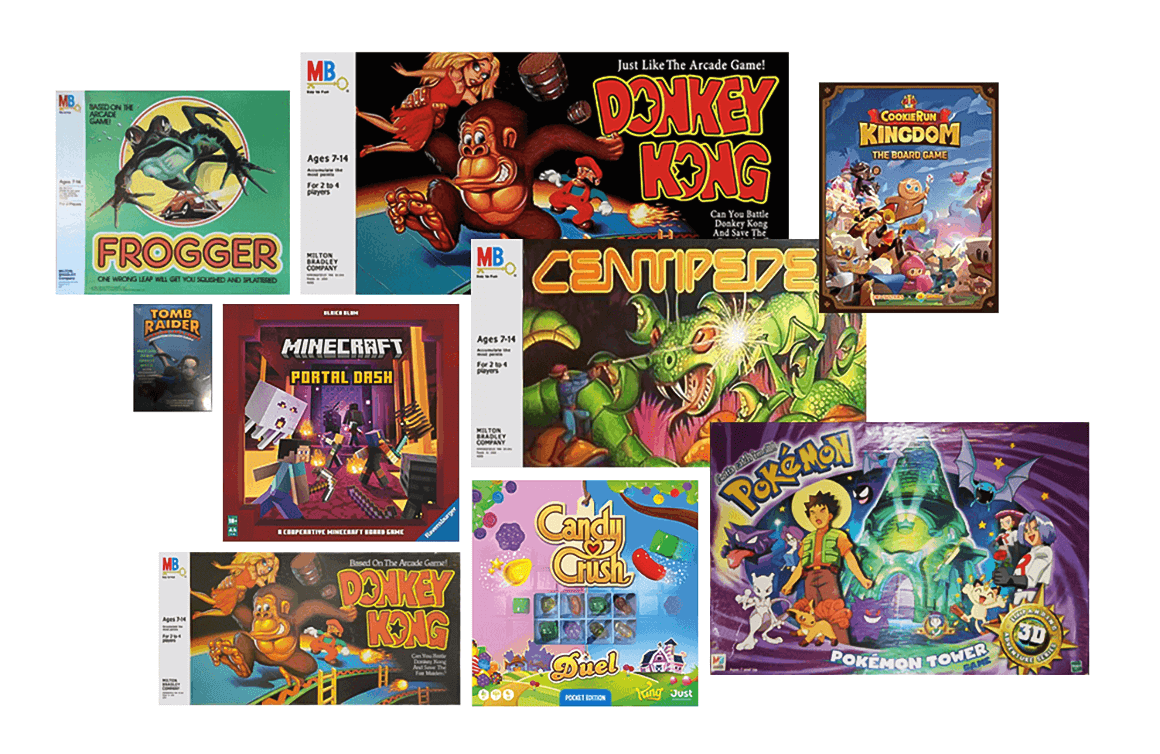Board games and card games that attempt to duplicate the look and play of video games, effectively or not, have been popular since video games began. Today, there are millions of video games, table games, and multiple hybrid examples. Games touch our thoughts, shape our pastimes, and influence other games we play. Games impact us, but they also impact other games.
1980s
Not surprisingly, the first video-themed board games emulated the first video (arcade) games. The Donkey Kong board game of 1981 — the same year as the arcade game — had players climb rows of girders, jump over plastic barrels, and avoid fireballs on a fold-out game board. This and the two other first board game simulations — Space Invaders (arcade 1978, board game 1981) and Frogger (both, 1981) — targeted a younger crowd. Early arcade games were relatively simple, and the board games often simplified the gameplay further. But fans of all ages loved them.
1990s and Early 2000s
Skipping ahead about 20 years, from the late 1990s to the early 2000s the list of analogue games grew to include many interpretations of Pokémon, first commonly recognized as a video role-playing game on Nintendo’s Game Boy. Table-game versions include a Pokémon Battling Coin Game, Pokémon Tower, a Hasbro spin-off called Pokémon Silph Co., and more. Meanwhile, a new (1999) Donkey Kong board game appeared, as well as board game forms of Centipede, Starcraft Spawn, a Tomb Raider collectible card game, and an “electronic” board game version of Whac-a-Mole. Instead of whacking moles down, players aim for lights on their heads with soft plastic mallets. The game was popular enough to inspire a Spanish edition, Electronico Guaca-Mole. How long did these games endure?
2020 and Beyond
Since 2020, the number of video games, including born-digital multiplayer online games, as well as analogue simulations, has increased exponentially. Candy Crush Duel board game appeared in 2020, and Resident Evil 3: The Board Game-The Last Escape, in 2021. Players delight in surviving magma, defeating monsters, and grabbing portal stones on a game board in Minecraft: Portal Dash (2022). Miniature figures replicate video game play in many versions, including World of Tanks, Street Fighter, and Warhammer. Board game examples simulate video expansions in games such as The Elder Scrolls V: Skyrim, Monster Hunter World, and Cookie Run, all in 2022. And contemporary games include multiple versions of all the classics we’ve seen before. Donkey Kong, Pokémon, Space Invaders, and the evergreen Pac-Man are just some of the board games continually reworked, appealing to those who played them in the past and contemporary players who want to try a classic in cardboard.
Without considering the thousands of video-game versions of proprietary games like Mario Bros. Monopoly and Risk: Halo Wars, it is still easy to see that video games inspire table games. But the reverse is also true. There are hundreds of electronic versions of games like Monopoly and Clue, video versions of role-playing games such as Dungeons & Dragons, and of the most ancient games like checkers and chess. The lists continue to grow as video games — and now table games — enjoy new highs in popularity.
Does anyone today know how to play the analogue version of Solitaire?
Note: If you buy something using the eBay link in this story, we may earn a small commission. Thank you for supporting independent toy journalism!

